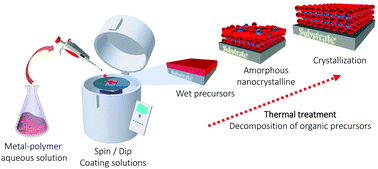Polymer assisted deposition of epitaxial oxide thin films
Abstract
Chemical solution methods for thin-film deposition constitute an affordable alternative to high-vacuum physical technologies, like Sputtering, Pulsed Laser Deposition (PLD) or Molecular Beam Epitaxy (MBE). Particularly, chemical methods have proven to be very suitable for producing functional films over large areas, especially in the relatively thick range, from >100 nm to microns. Also, their versatile ability to synthesize different types of materials, i.e. carbides, silicides, pnictides, oxides or chalcogenides, makes them very attractive for a wide range of applications and studies. However, problems with surface/interface roughness, control of stoichiometry in multicationic or precisely-doped materials, and a lack of accurate control of the thickness in the thin limit range (<20 nm) has reduced the competitiveness of these processes over high vacuum physical methods. This is particularly true in the case of multicationic oxide thin-films, which have experienced frantic research activity in recent years associated with phenomena of interactions across atomically sharp interfaces; the vast majority of oxide thin films used in these studies were deposited under high vacuum. Here, we review the Polymer Assisted Deposition (PAD) of epitaxial thin-films, with particular emphasis on the case of oxides. As we will show in this review, PAD is very versatile for producing different structural phases (perovskites, spinels, garnets, etc.), demonstrating its competitiveness in producing oxide thin-films with the quality required for fundamental studies and applications, as well as its complementarity to physical methods for stabilizing metastable materials and composite heterostructures. We also provide a detailed step by step description of the most relevant chemical aspects of the method, in order to make it reproducible and attractive to laboratories with little experience in complex chemistry tasks.

- This article is part of the themed collection: Recent Review Articles


 Please wait while we load your content...
Please wait while we load your content...